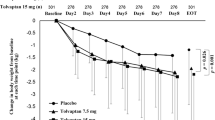Abstract
Ten patients with ascites due to chronic liver disease were treated with spironolactone as the sole diuretic in doses of 300 to 600 mg daily. Prior to spironolactone treatment ascites was relatively refractory as indicated by baseline 24-hr urine sodium values of less than 5 mEq and natriuresis of less than 30 mEq following 200 mg hydrochlorothiazide. With spironolactone, mean daily weight loss was 540 g and natriuresis 74 mEq; diuresis was considered satisfactory in nine of ten patients. Untoward effects were limited to a single episode of hepatic encephalopathy, a small fall in serum magnesium in several patients, and three instances of hyperkalemia (5.5, 5.6, and 7.5 mEq/liter). In spite of the tendency to hyperkalemia, urinary potassium excretion increased in seven of the ten patients. There was no rise in serum urea nitrogen or creatinine. Hydrogen ion excretion decreased initially leading to mild hyperchloremic acidosis. Serum urate did not increase.
Similar content being viewed by others
References
Earley LE: Edema formation and the use of diuretics. Calif Med 114:56–63, 1971
Singer MM, DeGraff AC: Diuretic therapy. Part VII. Spironolactone. Am Heart J 68:835–837, 1964
Goldberg M: Panel discussion. Diuretics in Clinical Medicine. F Hoffman (ed). Amsterdam, Excerpta Medica Foundation, 1967, p 93
Eggert RC: Spironolactone diuresis in patients with cirrhosis and ascites. Br Med J 4:401–403, 1970
Radó JP, Marosi J, Takó J: High doses of spironolactone (Aldactone, SC-14266, Verospirone) alone and in combination with triamtirene and/or diuretics in the treatment of refractory edema associated with secondary hyper-aldosteronism. Endokrinologie 57:46–62, 1970
Bonsnes RW, Taussky HH: On colorimetric determination of creatinine by the Jaffee reaction. J Biol Chem 158:581–591, 1945
Kern A, Stransky E: Bietrag zue kolorimetrischen bestimmring der harnsäure. Biochem Z 290:419–427, 1937
Clark E: Spironolactone therapy and gynecomastia. JAMA 193:163–164, 1965
Shear L, Ching S, Gabuzda GJ: Compartmentalization of ascites and edema in patients with hepatic cirrhosis. N Engl J Med 282:1391–1396, 1970
Sherlock S, Walker JG, Senewiratne B, Scott A: The complications of diuretic therapy in patients with cirrhosis. Ann NY Acad Sci 139:497–505, 1966
Ogden DA, Scherr L, Spritz N, Rubin AL: A comparison of the properties of chlorothiazide, spironolactone and a combination of both as diuretic agents. N Engl J Med 265:358–362, 1961
Jick H, Morrison RS, Moore EW, Chalmers TC: Metabolic studies on the effects of spironolactone. Metabolism 12:381–387, 1963
Manuel MA, Beirne GJ, Wagnild JP, Weiner MW: An effect of spironolactone on urinary acidification in normal man. Arch Intern Med 134:472–474, 1974
Author information
Authors and Affiliations
Rights and permissions
About this article
Cite this article
Campra, J.L., Reynolds, T.B. Effectiveness of high-dose spironolactone therapy in patients with chronic liver disease and relatively refractory ascites. Digest Dis Sci 23, 1025–1030 (1978). https://doi.org/10.1007/BF01263103
Issue Date:
DOI: https://doi.org/10.1007/BF01263103




